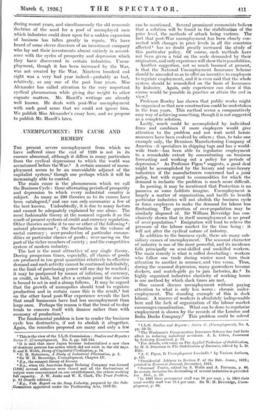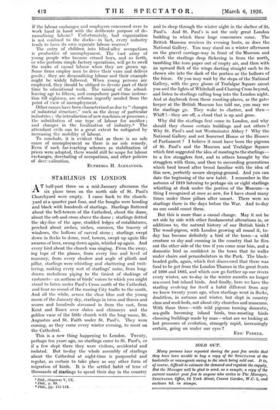. UNEMPLOYMENT: ITS CAUSE AND REMEDY Tan present severe unemployment
from which we have suffered since the end of 1920 is not in its essence abnormal, although it differs in many particulars from the cyclical depressions to which the world was accustomed-before the War." A certain amount of unem- ployment seems to be an unavoidable adjunct of the capitalist system,2 though one perhaps which it will be increasingly able to control.
The main cause is the phenomenon which we call the Business Cycle : those alternating periods of prosperity and depression to which every industrial country is subject. As many as 230 theories as to its causes have been catalogued,' and one can only summarize a few of the best known. Undoubtedly, it is due to many factors and cannot be adequately explained by one alone. The most fashionable theory at the moment regards it as the result of present systems of credit and currency regulation. Other theories ascribe it to one or other of the following 4 : natural phenomena 5 ; the fluctuation in the volume of metal currency ; over-production of particular commo- dities or particular classes of goods ; over-saving on the part of the richer members of society ; and the competitive system of modern industry. The last is the most attractive of any single theory. During prosperous times, especially, all classes of goods are produced in too great quantities relatively to effective demand and such activity cannot be continued indefinitely, as the limit of purchasing power will one day be reached ; it may be postponed by means of inflation, of currency, or credit, or both, but after a certain point the reaction is bound to set in and a slump follows. It may be argued that the growth of monopolies should tend to regulate production and in certain cases this is the result, 6 but on the other hand post-War experience reveals the fact that small businesses have had less unemployment than large ones. Perhaps the reason is that the trust of to-day tends to concern itself with finance rather than with economy of production? The fundamental problem is how to render the business cycle less destructive, if not to abolish it altogether. Again, the remedies proposed are many and only a few 1 This is the view of the I.L.O. Commission : Studies and Reports Series C. (Unemployment). No. 8, pp. 142-144. 1 It is said that since Japan became industrialized a new class of destitute persons has arisen which did not exist in the old days. S. and B. Webb, Decay of Capitalist Civilization, p. 14. 3 D. H. RobertsOn A Study of Industrial Fluctuation, p. 1. Sir W. H. Beveridge, Unemployment, Chapter IV.
5 E.g., the sunspot theory of Jevons. 6 E.g., when the American Sugar Refining Company was formed (1890) several refineries were closed and all the fluctuations of output were concentrated on one establishment, the others working full capacity. J. W. Jenks and W. E. Clark, The Trust Problem, 13. 43 (fourth edition). 1.0.g., Vide. Report on the. Soap Industry, prepared by the Sub- [Committee appointed under the Profiteering Acts, 1919-20. can be mentioned. Several prominent economists believe that a solution will be found in the stabilization of the price level, the methods of attack being various. The fact that post-War unemployment has been closely con- nected with changes in price levels in all the countries affected has no doubt greatly increased the study of this particular policy. Of course, such methods have not been given a trial on the scale demanded by their originators, and only experience will show their possibilities.
Another suggestion, not so much boomed at present, is that the National Unemployment Insurance Scheme should be amended so as to offer an incentive to employers to regulate employment, and it is even said that the whole system should be remodelled on the basis of Insurance by Industry. Again, only experience can show if this course would be possible in practice or attain the end in view.2 Professor Bowley has shown that public works might be organized so that new construction could be undertaken in the lean years. This method seems a comparatively easy way of achieving something, though it is not suggested as a complete solution.
Lastly, much could be accomplished by individual firms and combines if more employers would give attention to the problem and not wait until heroic measures have been evolved by others ; thus, to take one example only, the Dennison Manufacturing Company of America—it specializes in shipping tags and has a world- wide trade—has been able to regularize employment to a remarkable extent by concentrating on business forecasting and working out a policy for periods of depression.' As Professor Pigou 4 suggests, a good deal might be accomplished by the luxury and semi-luxury industries if the manufacturers concerned had a joint policy, but with regard to commodities for which the demand is inelastic the problem is much more difficult.
In passing, it may be mentioned that Protection is no panacea as some faddists imagine. Unemployment is largely a matter of organization, and tariffs to benefit particular industries will not abolish the business cycle or force employers to make the demand for labour less fluctuating. The question of over-population may be similarly disposed of. Sir William Beveridge has con- clusively shown that in itself unemployment is no proof of over-population.5 Emigration will tend to relieve the pressure of the labour market for the time being : it will not alter the cyclical nature of industry.
In addition to the business cycle, there arc many sub- sidiary causes of unemployment. The seasonal character of industry is one of the most powerful, and its incidence fails principally on semi-skilled and unskilled workers. The main remedy is what is called dovetailing : workers who follow one trade during winter must turn their attention to another in summer, and vice versa. Thus, during the seasonal depression, many gasworkers become dockers, and match-girls go to jam factories, &c.6 In highly organized industries elasticity of working hours is one method by which slack times are met. One cannot discuss unemployment without paying attention to what is only less worse : chronic under- employment. The standing example of this is dock labour. A reserve of workers is absolutely indispensable here and the lack of organization of the labour market encourages casualization. What can be done to regularize employment is shown by the records of the London and India Docks Company? This problem could be solved 1 I.L.O. Studies and Reports : Series C. (Unemployment), No. 8,
pp. 69-70.
2 The Workmen's Compensation Insurance Scheme has had little effect in reducing industrial accidents. J. L. Cohen, insurance by Industry Examined, p. 73. 2 For details, vide essay on The Applied Technique of Stabilization, by H. S. Dennison in The Stabilization of Business, edited by L. D.
Edie.
A. C. Pigou, 18 Unemployment Inevitable Y by Various Authors,
p. 125.
5 Presidential Address to Section F. of the Brit. Assoc., 1923 ; printed in Economic Journal, December, 1923. Seasonal Trades, edited by S. Webb and A. Freeman, p. 46. In certain factories the dovetailing of several industries is provided for. Ibid., p. 58. 1In 1887 their permanent staff was 16 per cont. ; in 1904 their total weekly staff was 78.4 per cent. Sir W. H. Beveridge, Unem- ployment, p. 89. if the labour exchanges and employers concerned were to work hand in hand with the deliberate purpose of de- casualizing. labour.' Unfortunately, bad organization is not confined to the docks—in fact, every industry tends to have its own separate labour reserve.2 The entry of children into blind-alley occupations is productive of unemployment. The vast army of young people who become errand boys, and so forth, or who perform simple factory operations, will go to swell the ranks of, casual labour when they are grown up. Some firms employ men to drive their vans and deliver goods ; they are decasualizing labour and their example might be widely followed. When young persons are employed, they should be obliged to devote part of their time to educational work. The raising Of the school- leaving age to fifteen, and compulsory part-time instruc- tion till eighteen, are reforms urgently needed from the point of view of unemployment.
Other causes have been characterized as due to " changes of industrial structure," such as the decay of particular industries ; the introduction of new machines or processes ; the subStitution of one type of labour for another ; and changes in the localization of industry.3 The attendant evils can to a great extent be mitigated by increasing the mobility of labour. To conclude, it is evident that as there is no sole cause of unemployment so there is no sole remedy. Even if such far-reaching schemes as stabilization of prices were adopted, there would still be scope for labour exchanges, dovetailing of occupations, and other policies of deca"ualization.
EUPHEMIA H. ALEXANDER.







































































 Previous page
Previous page